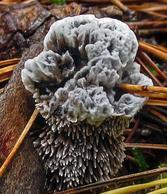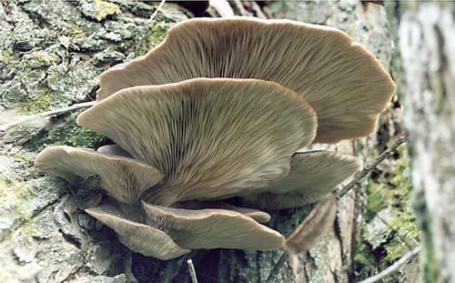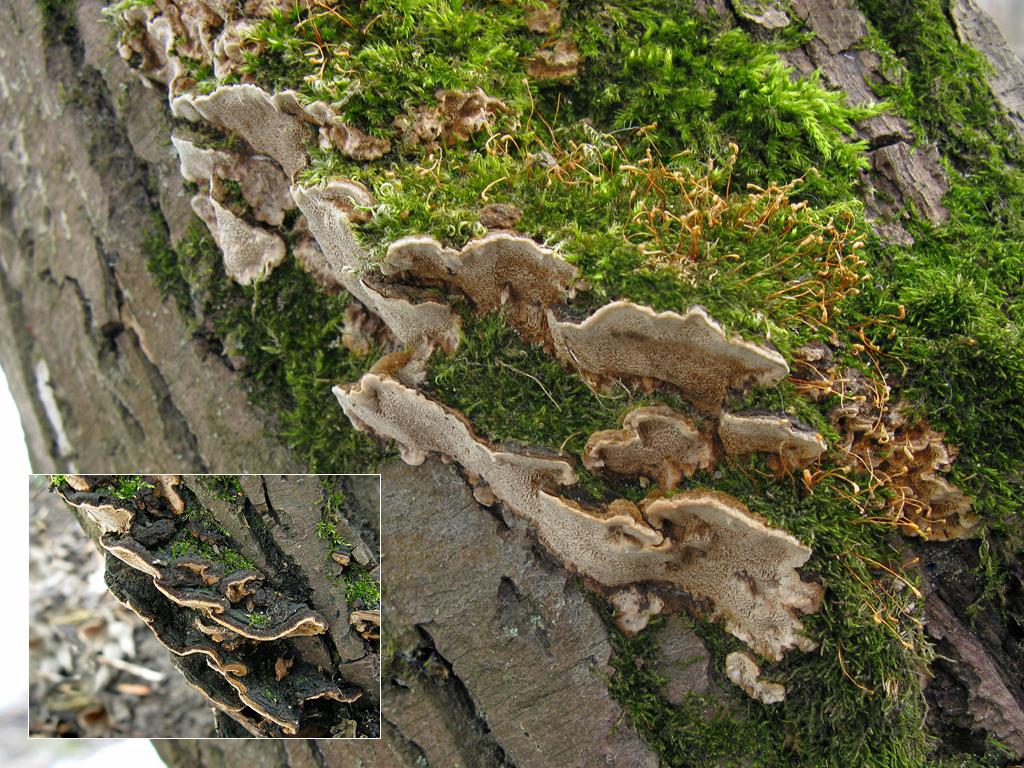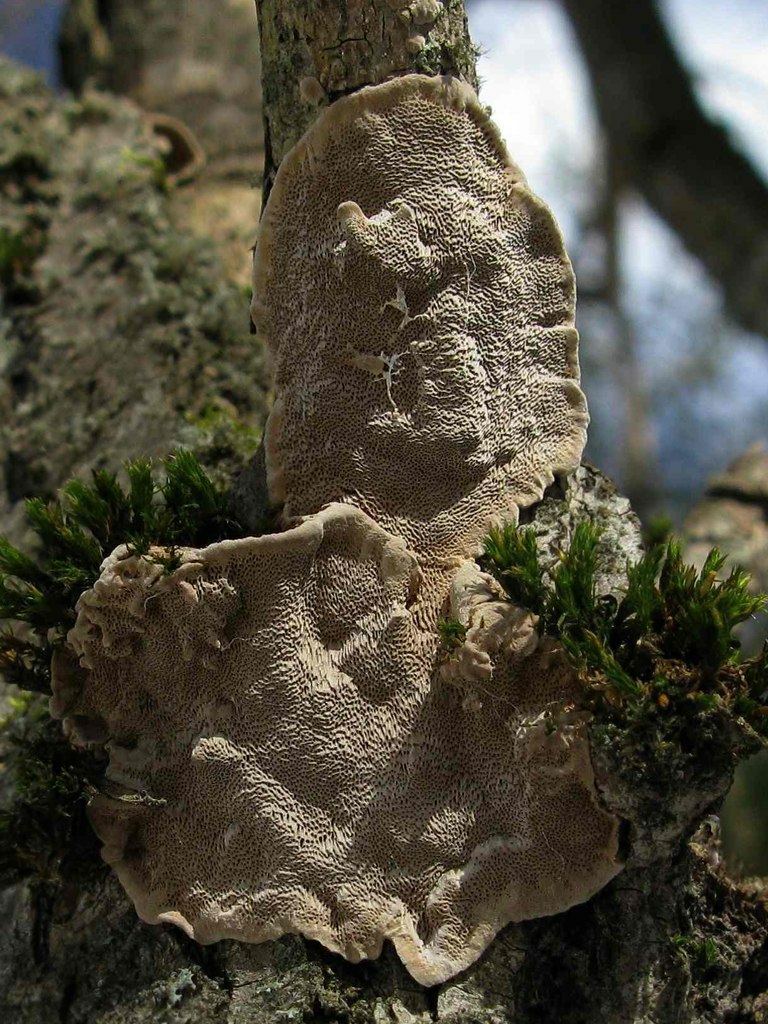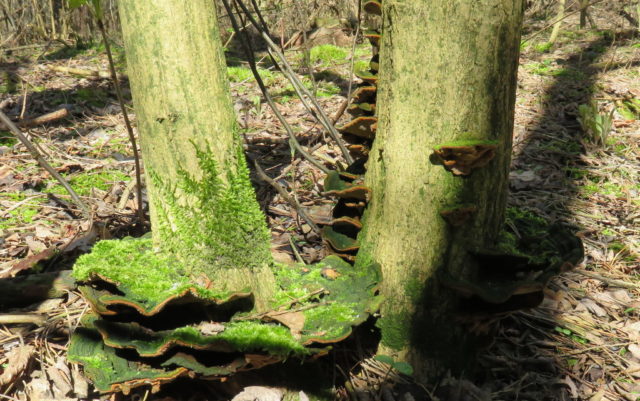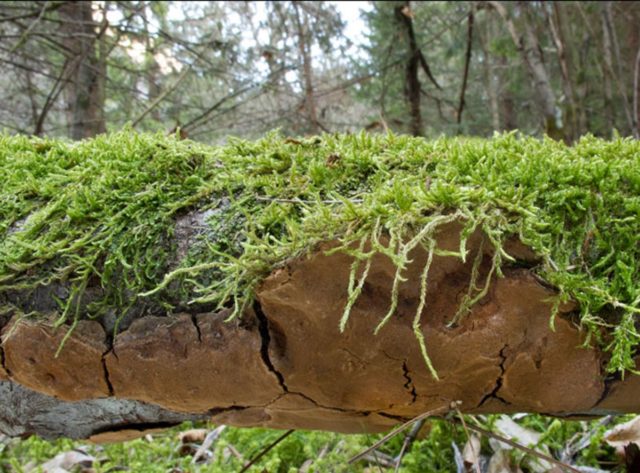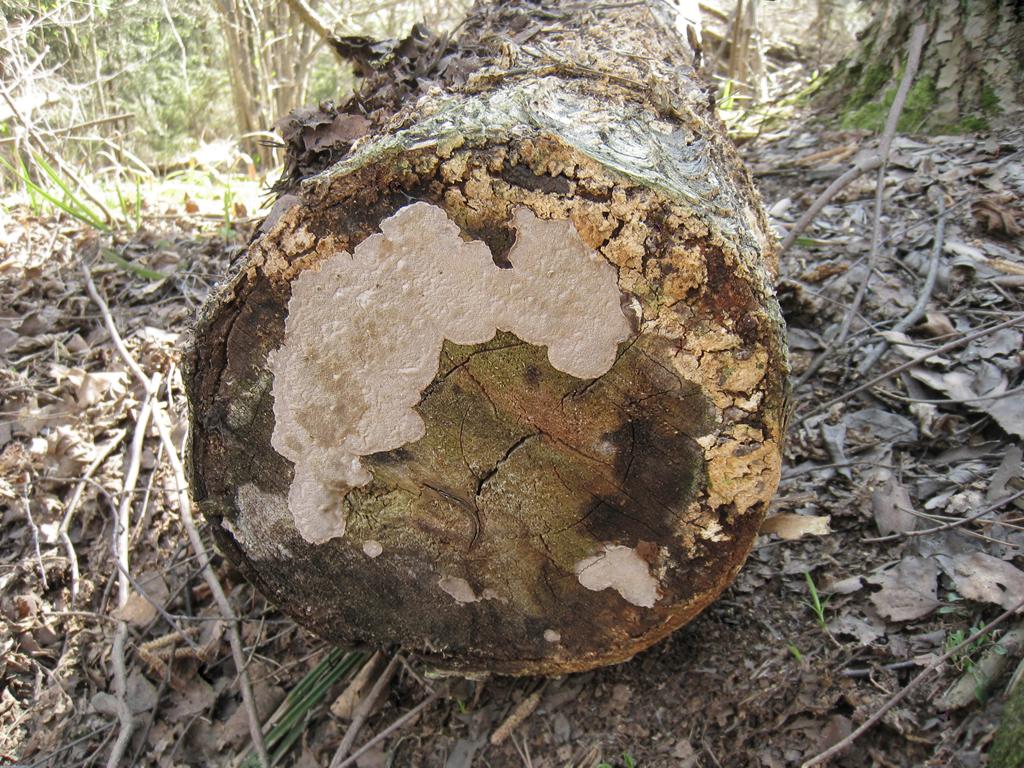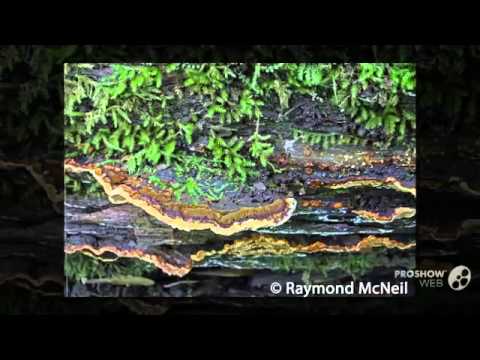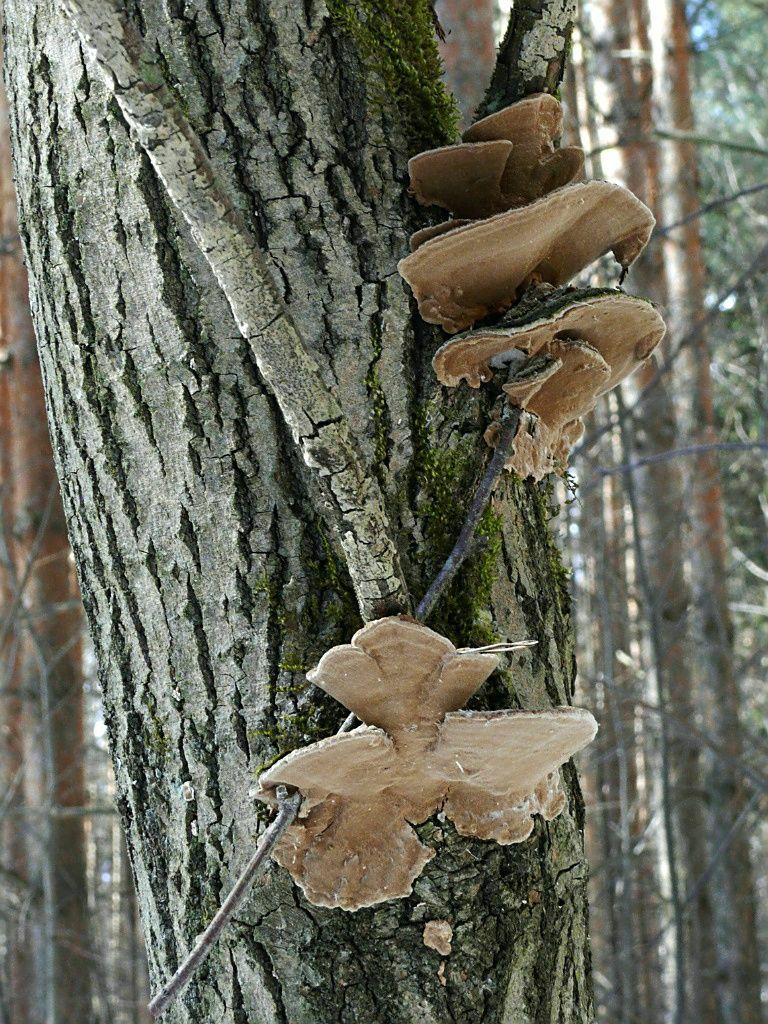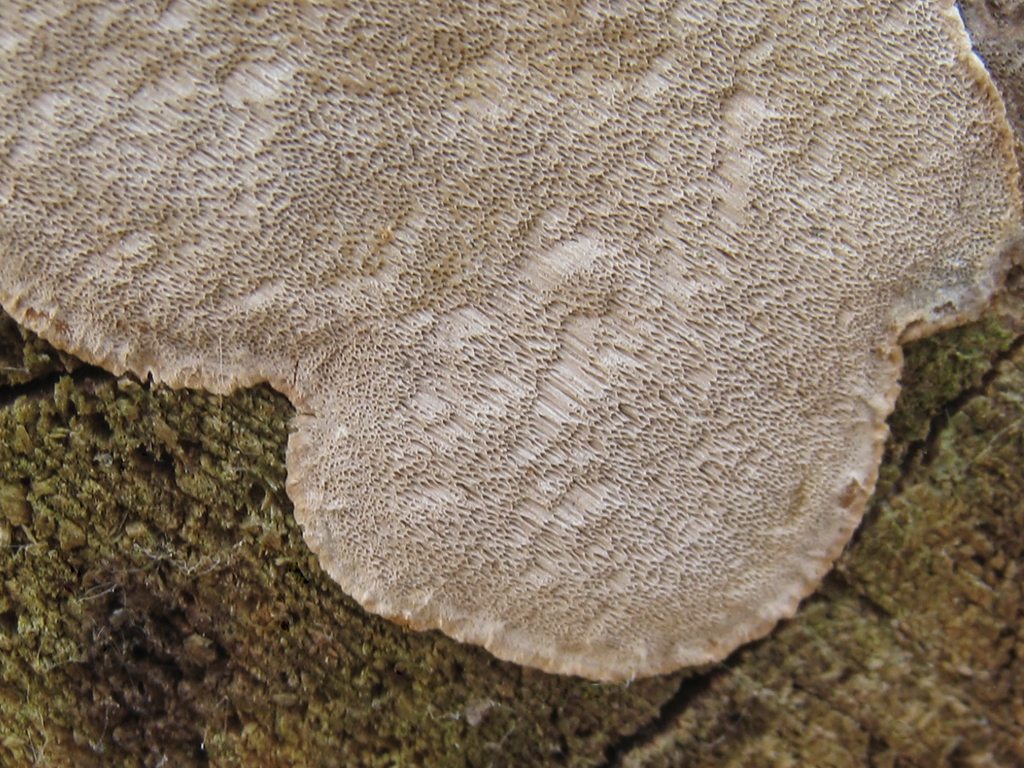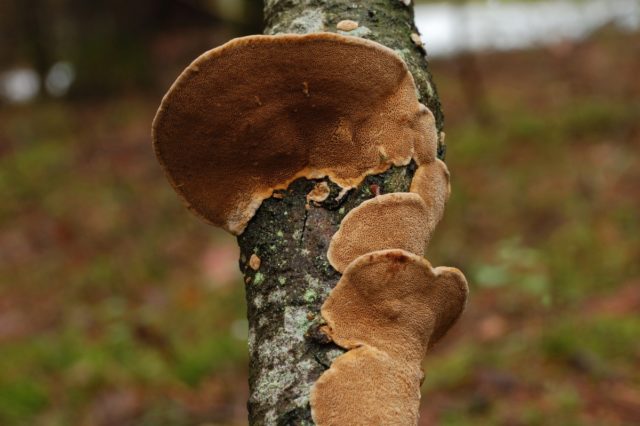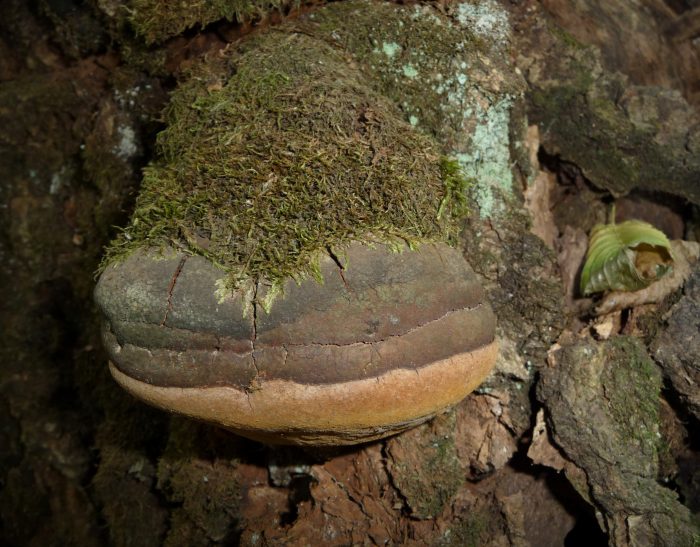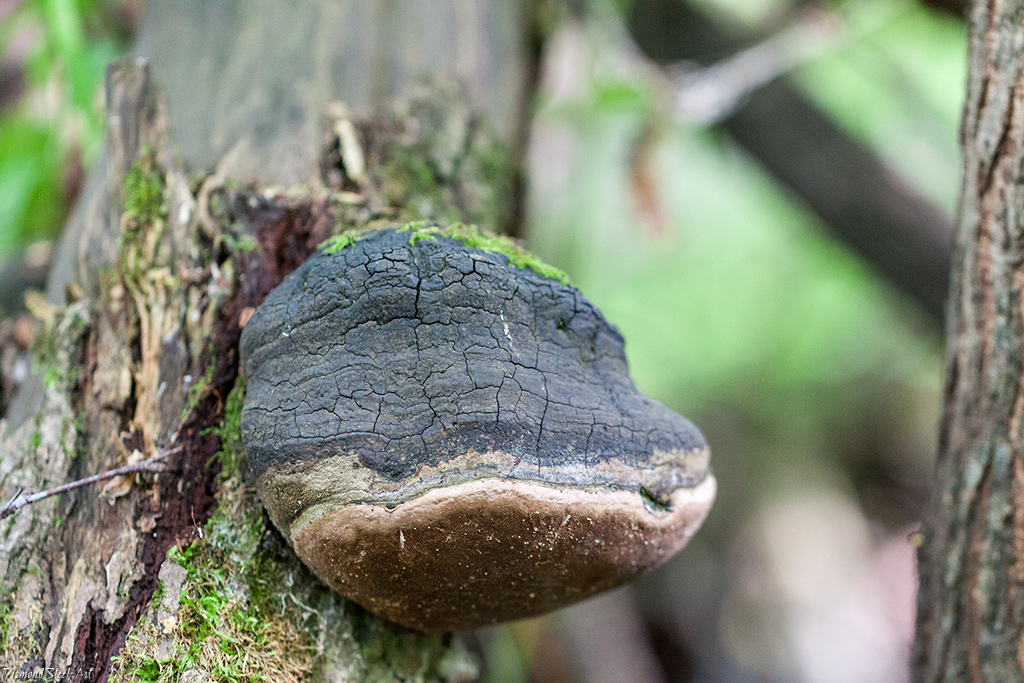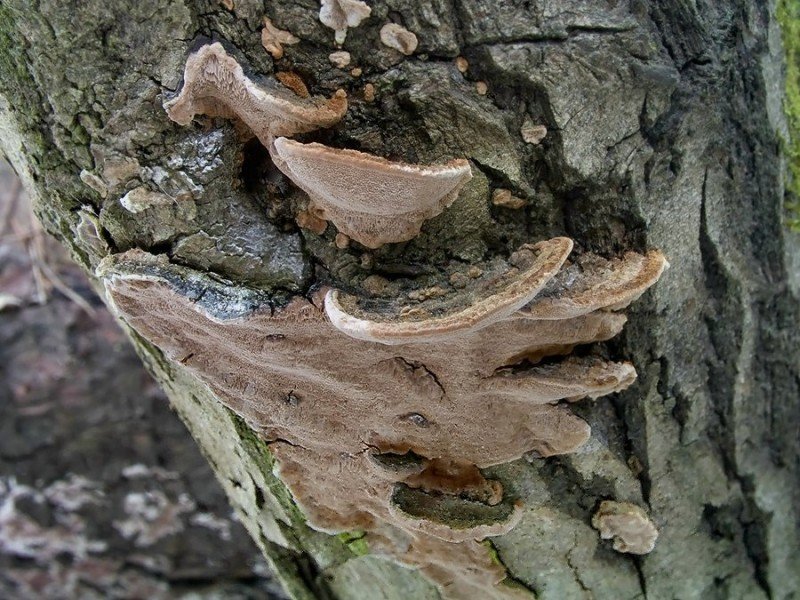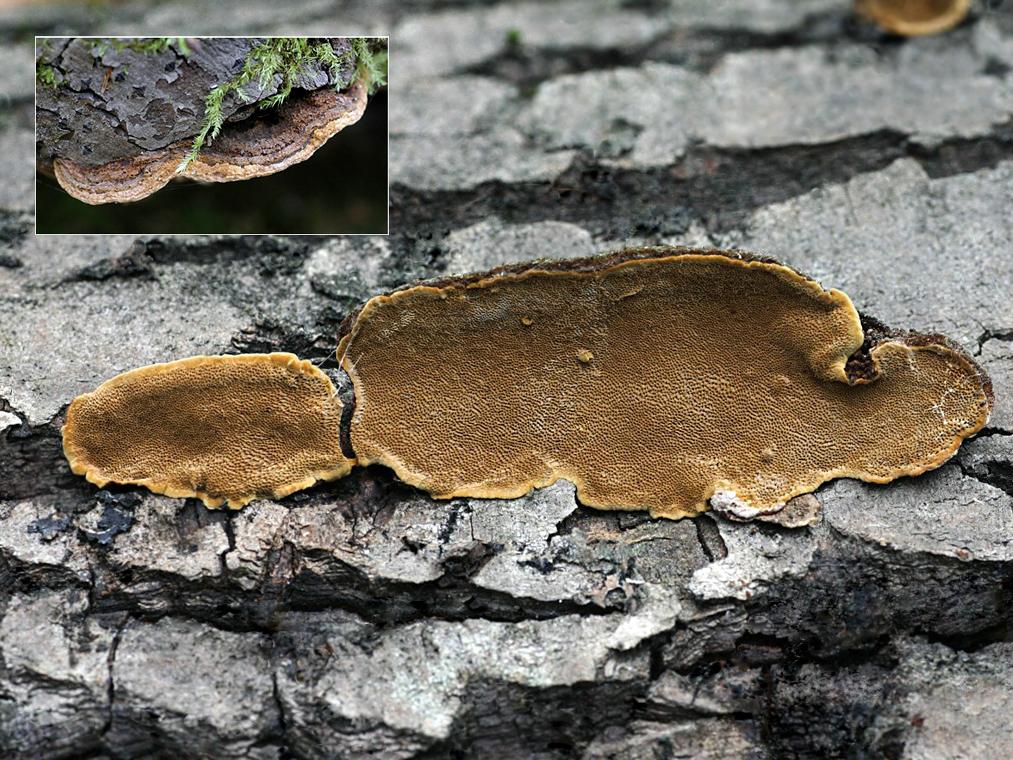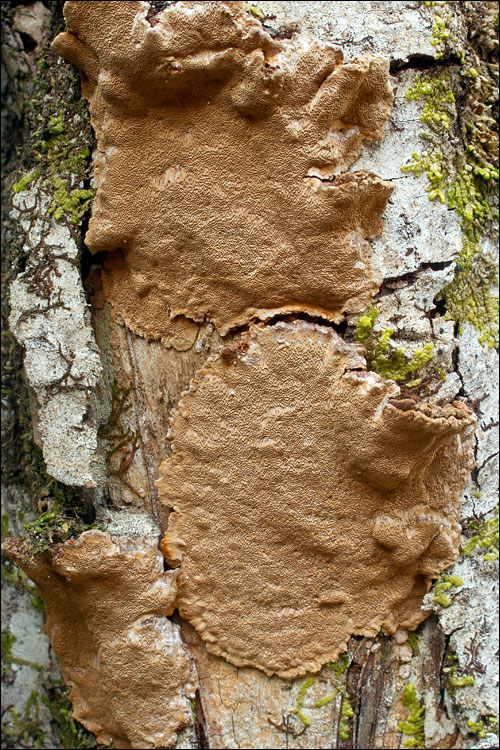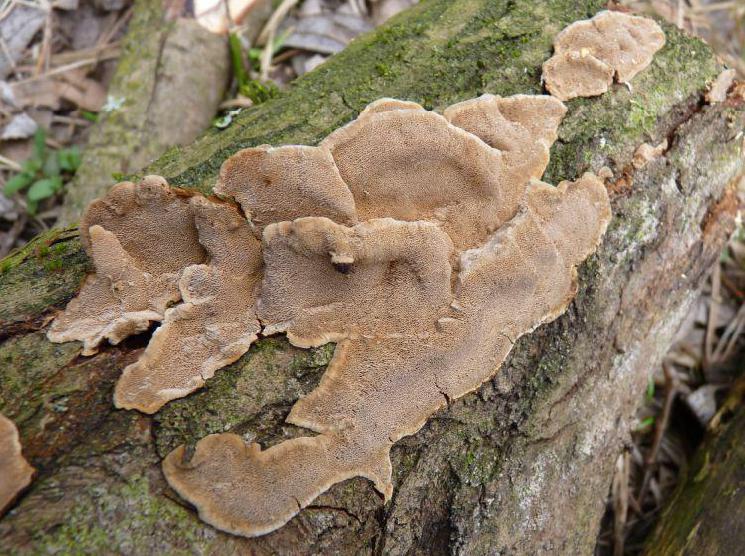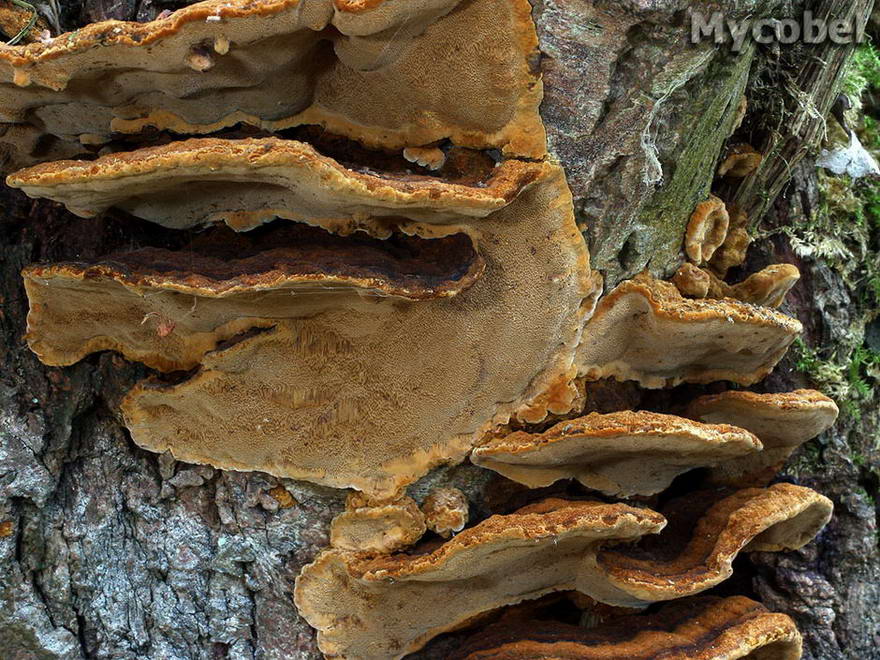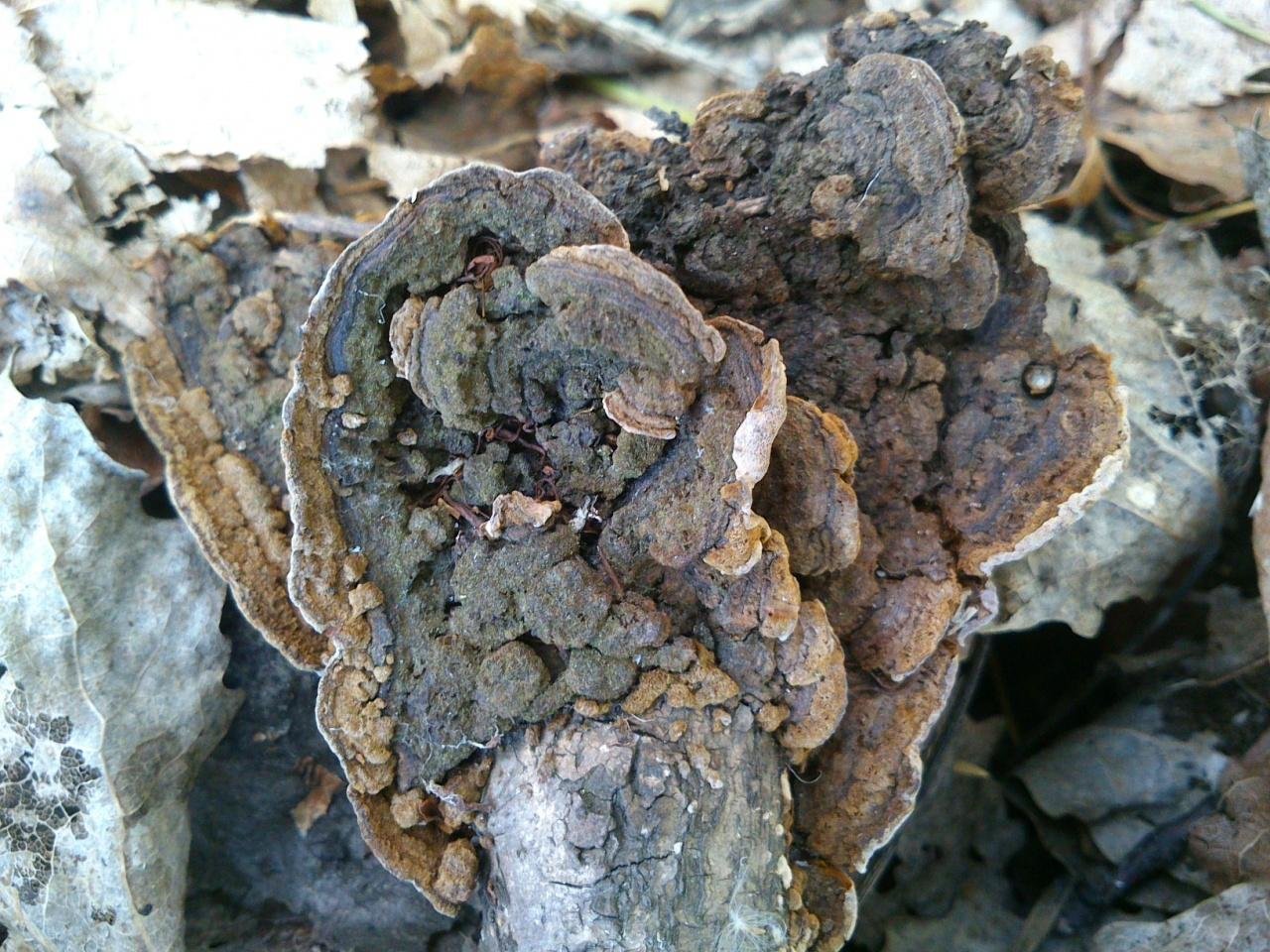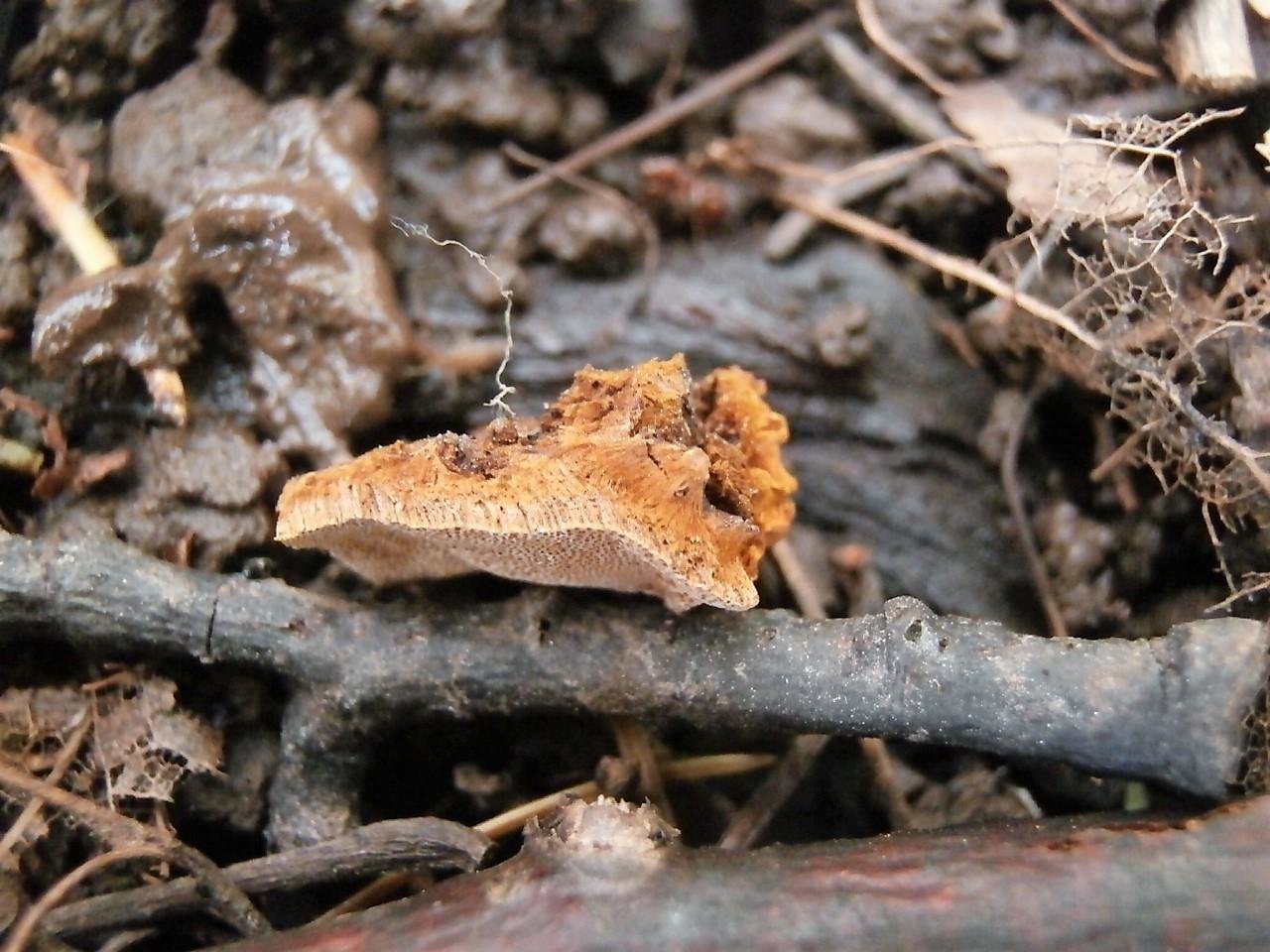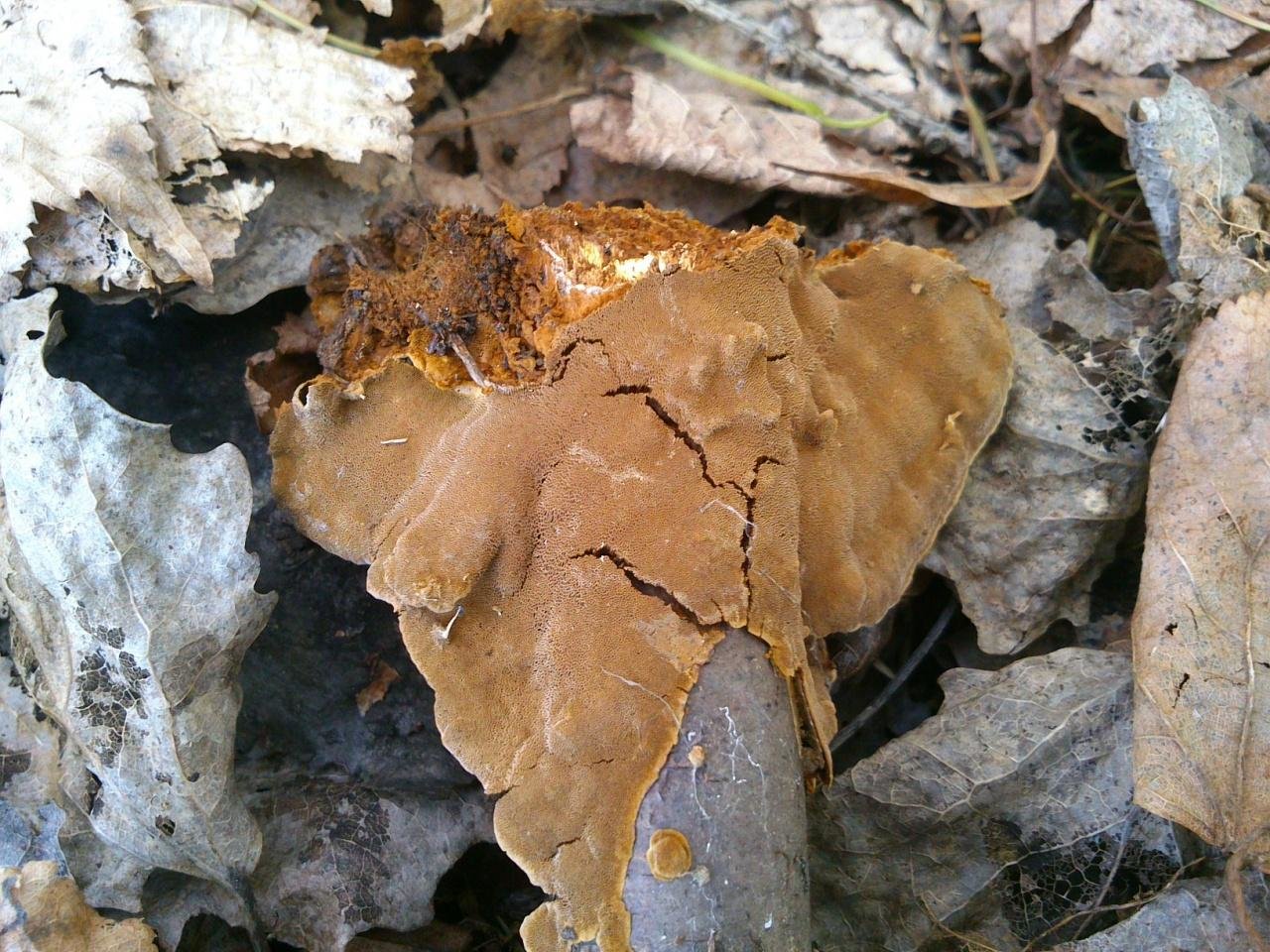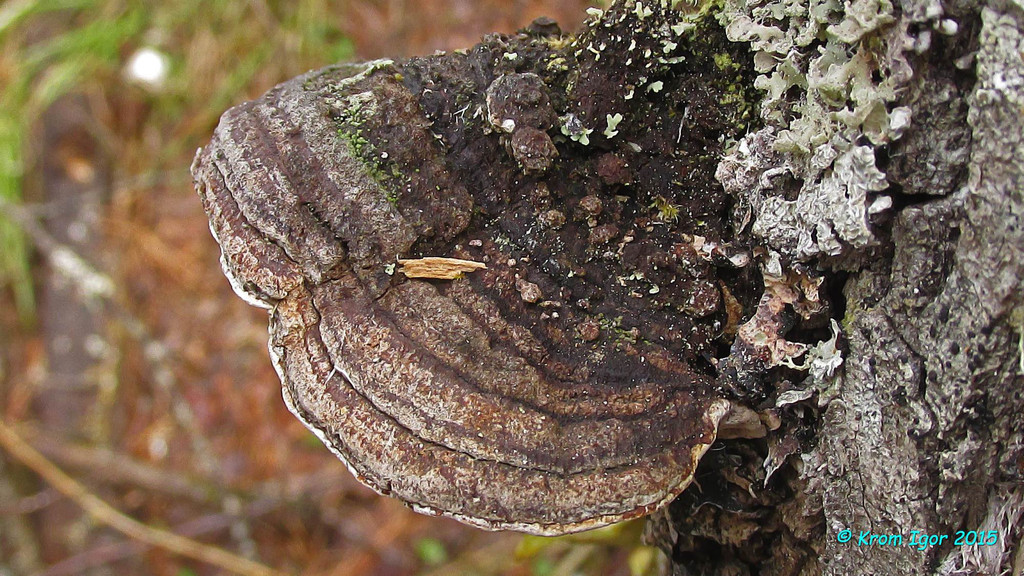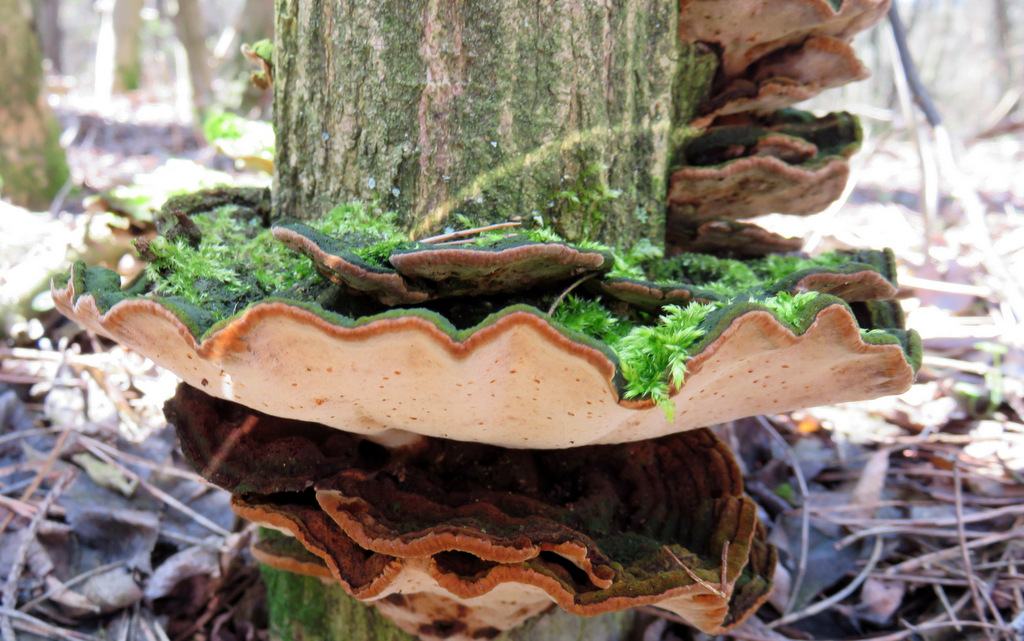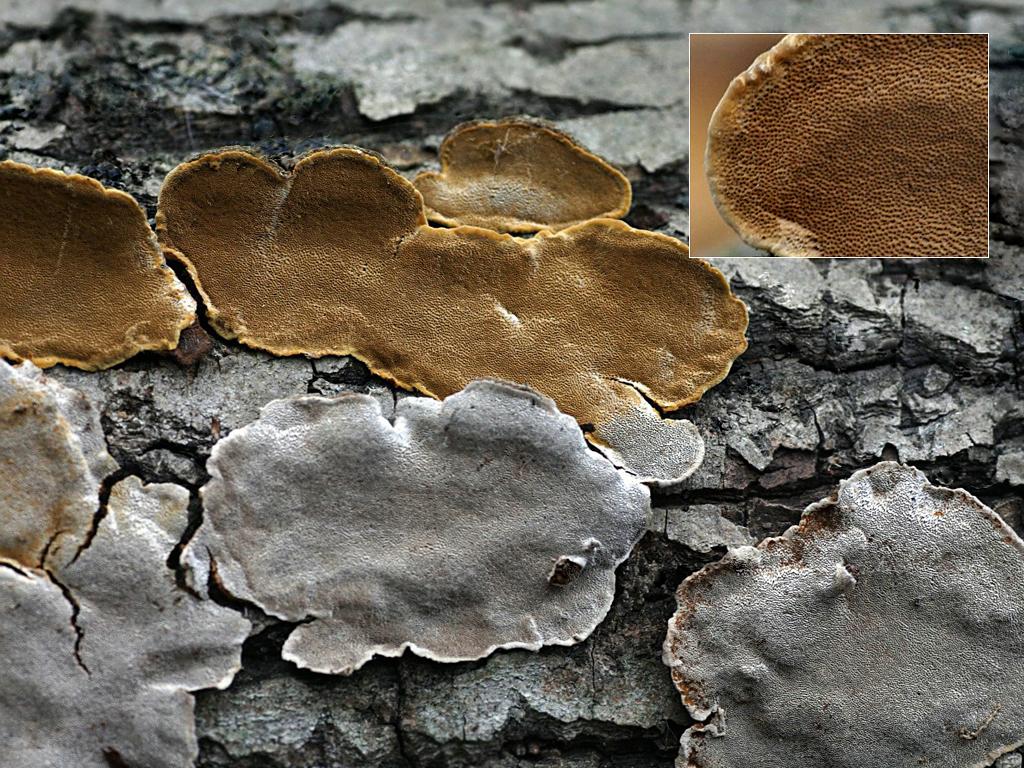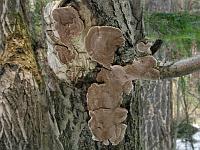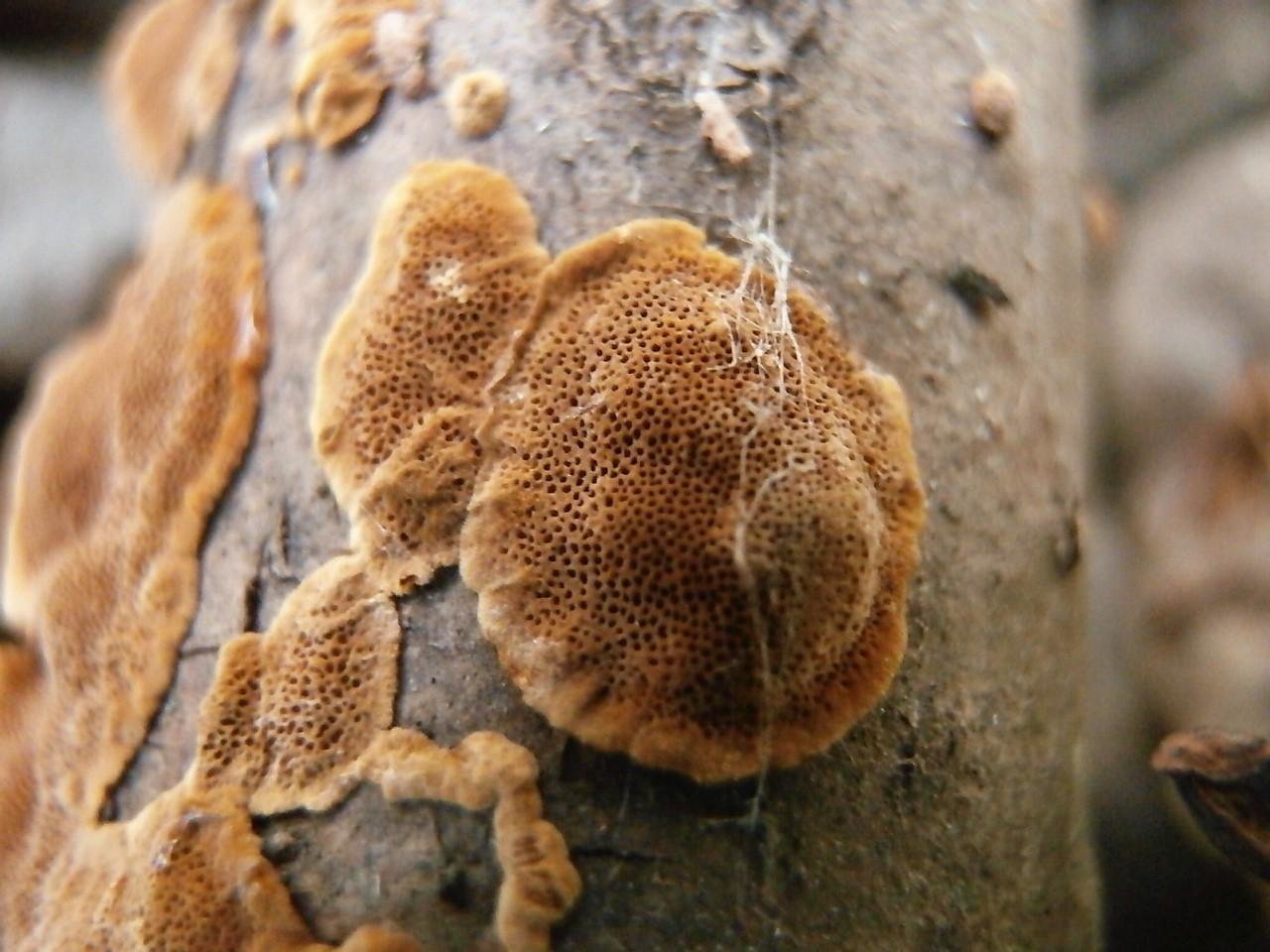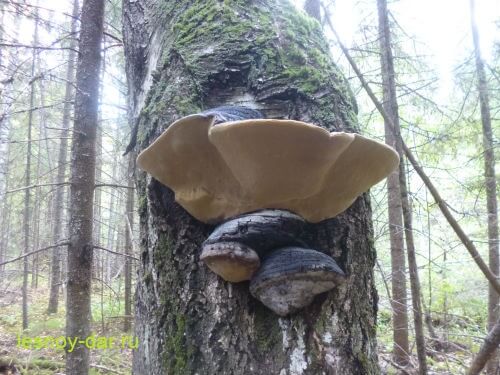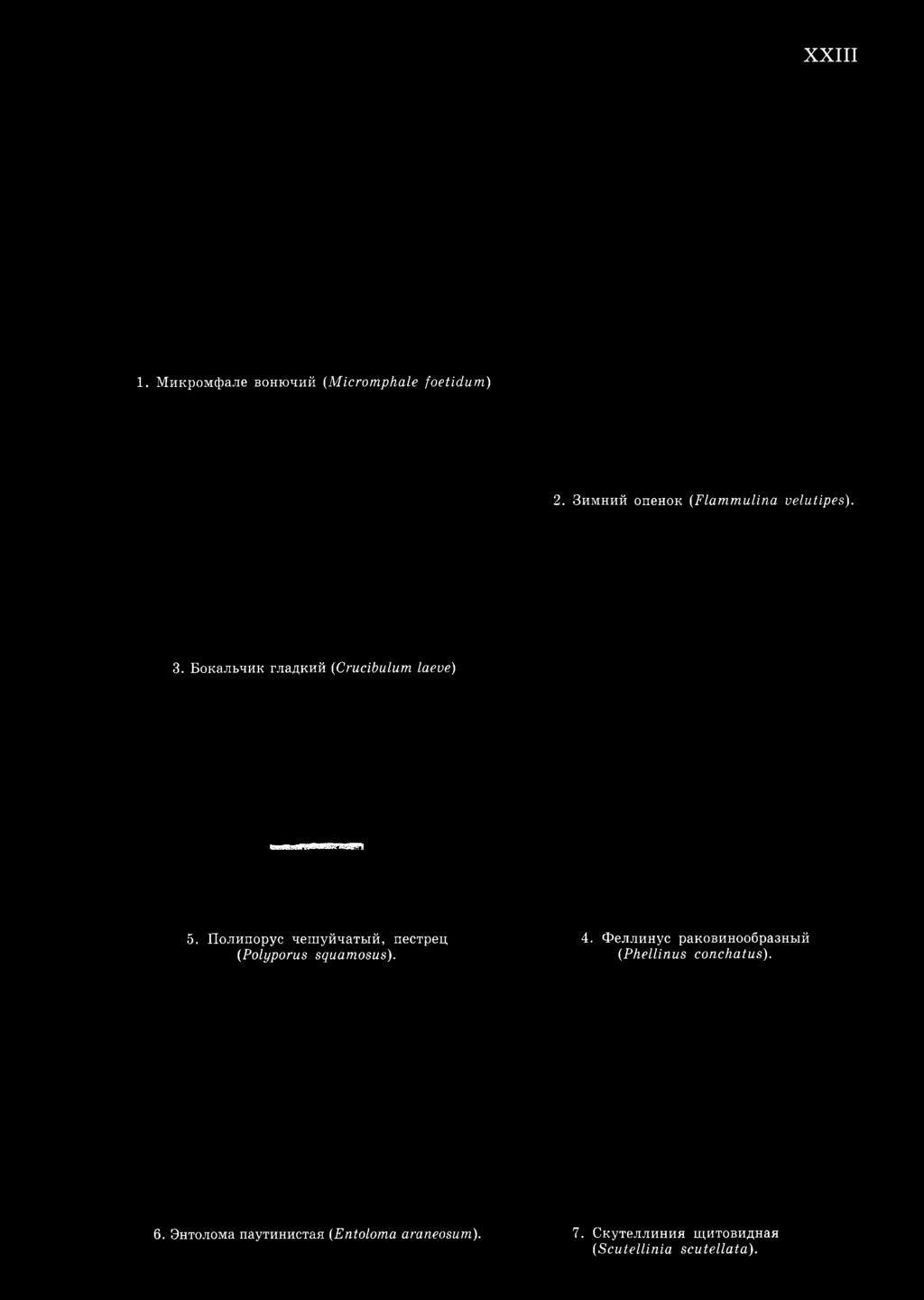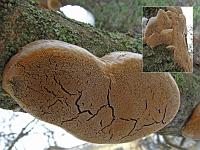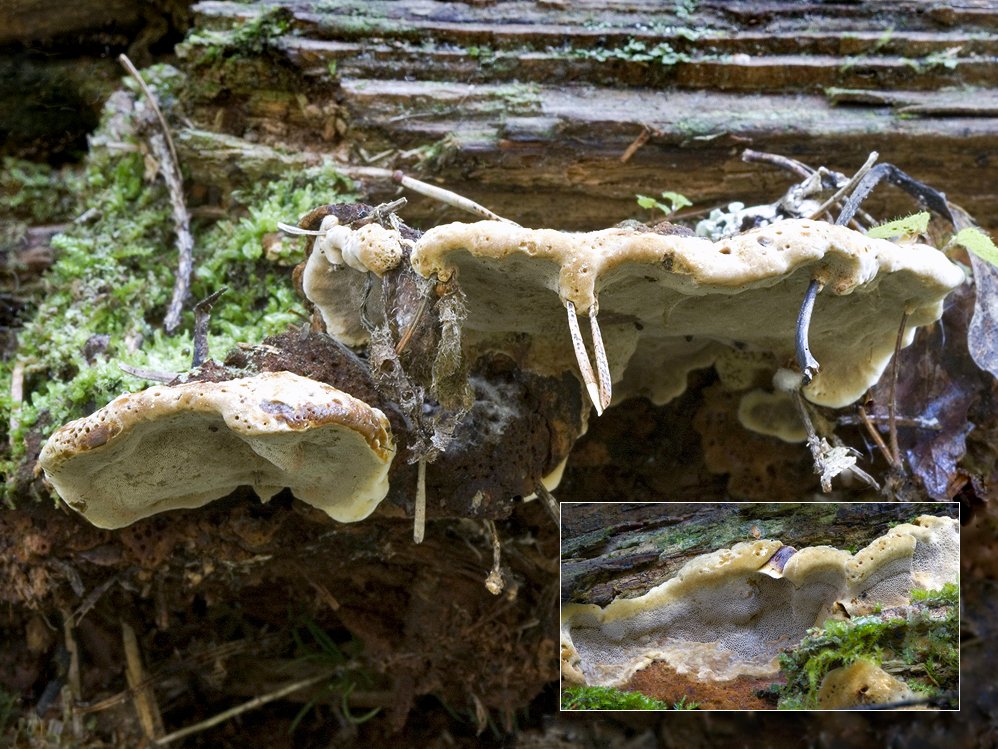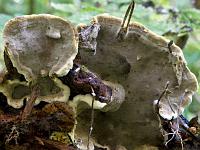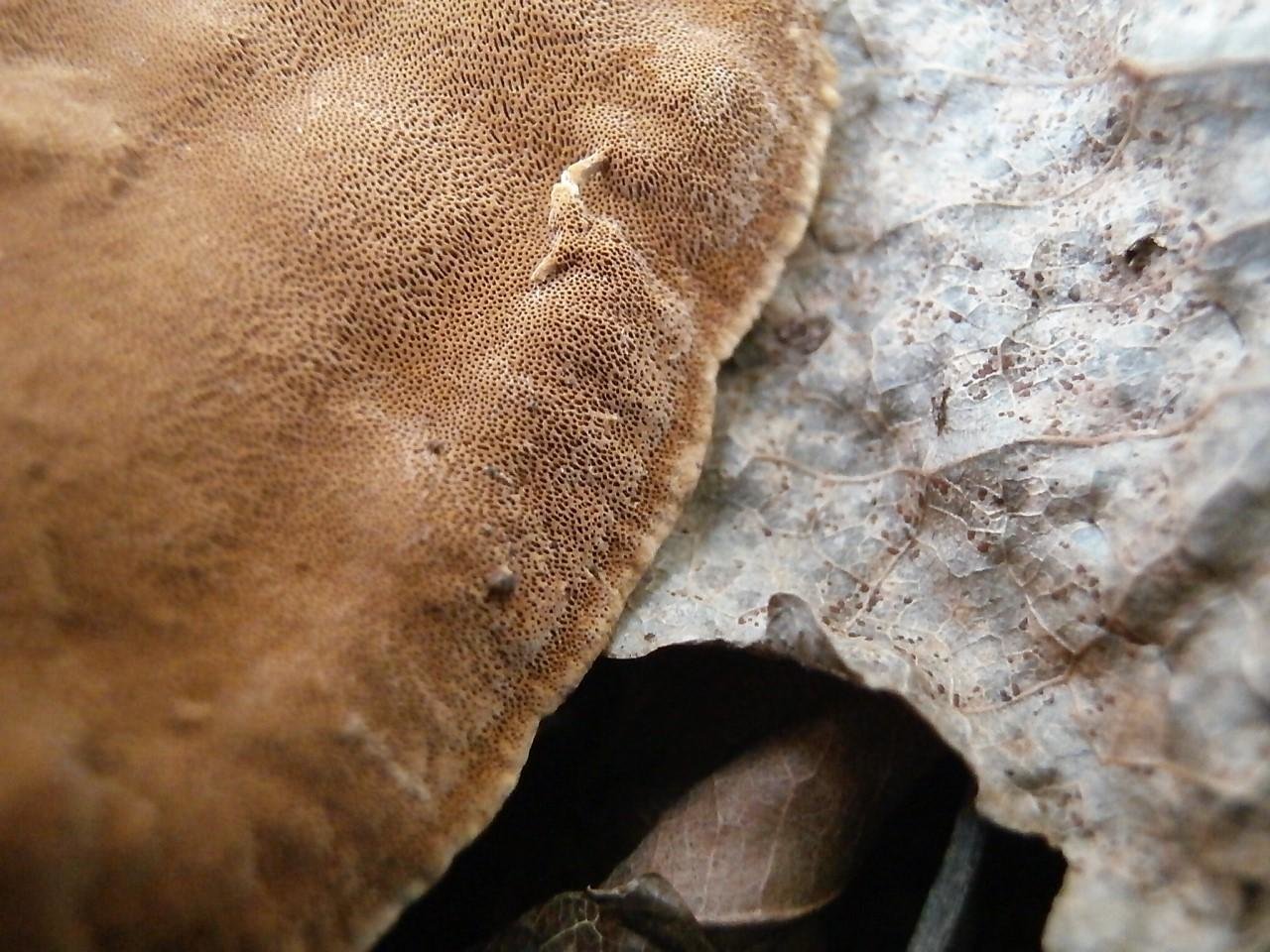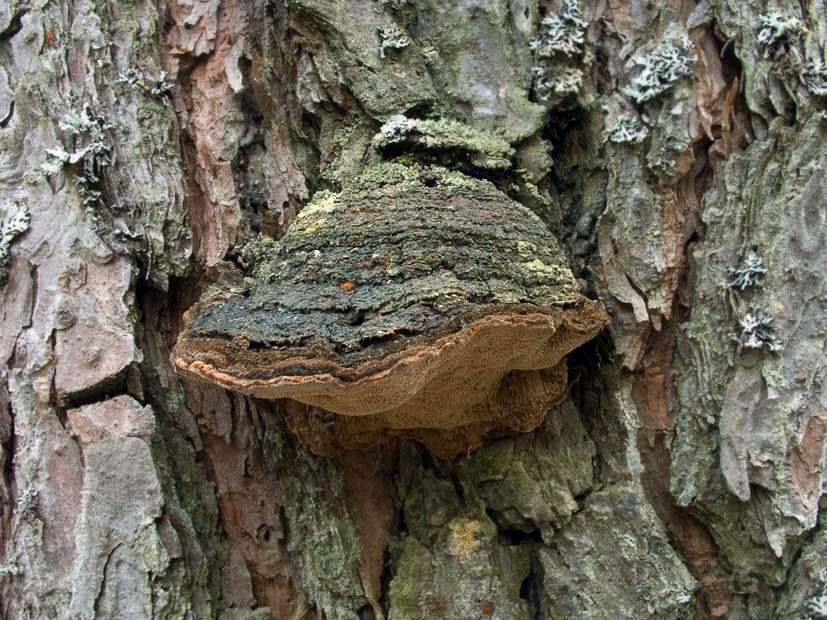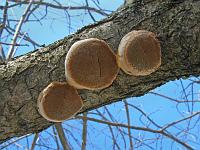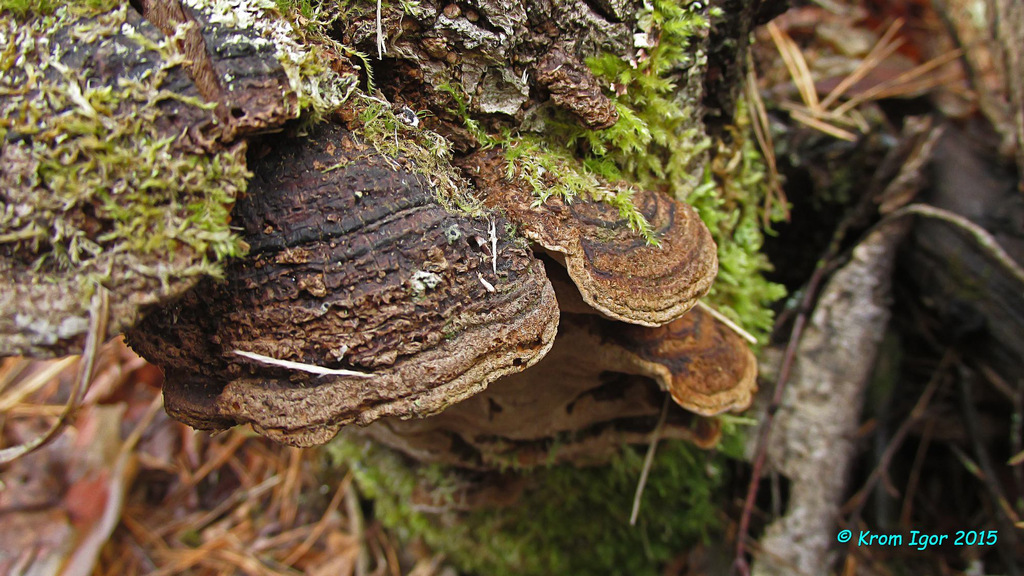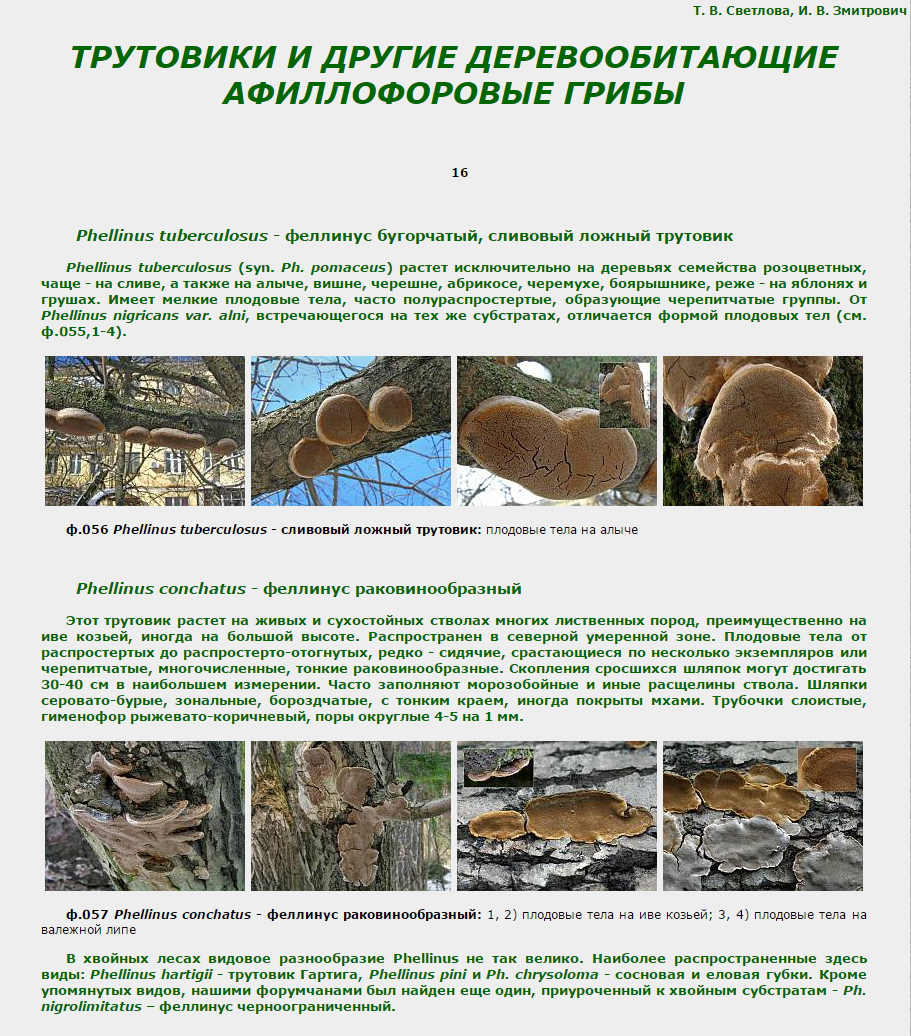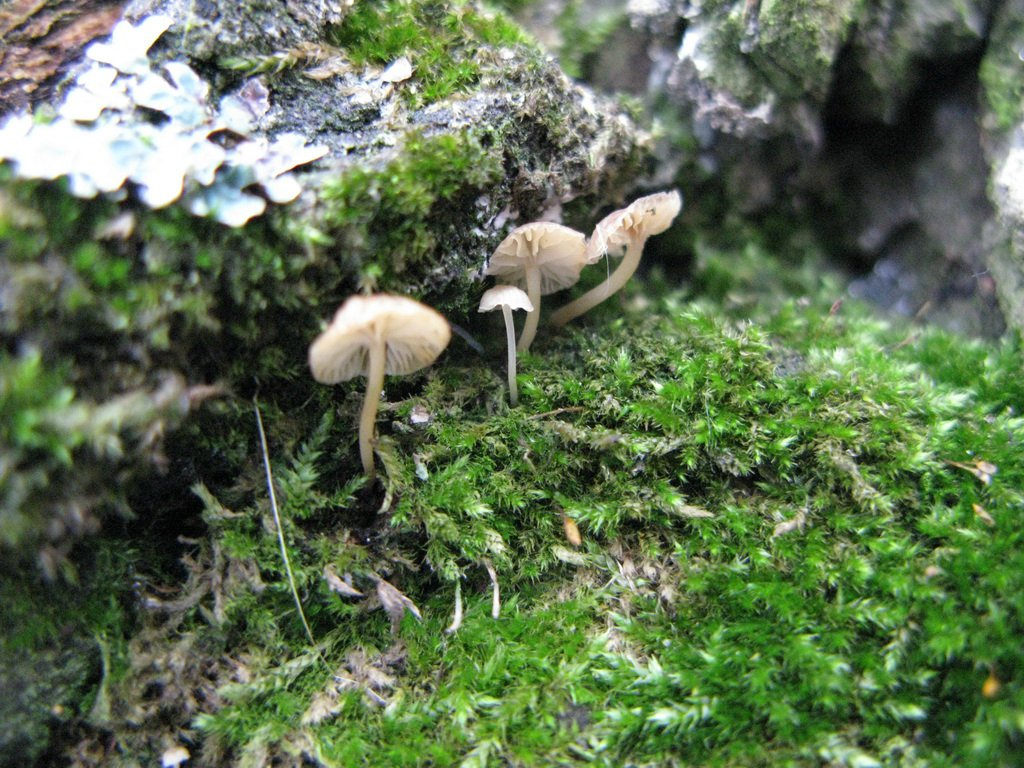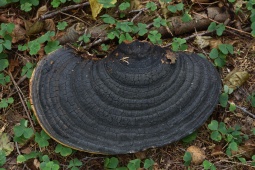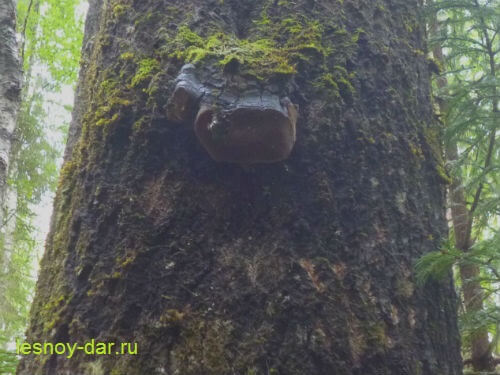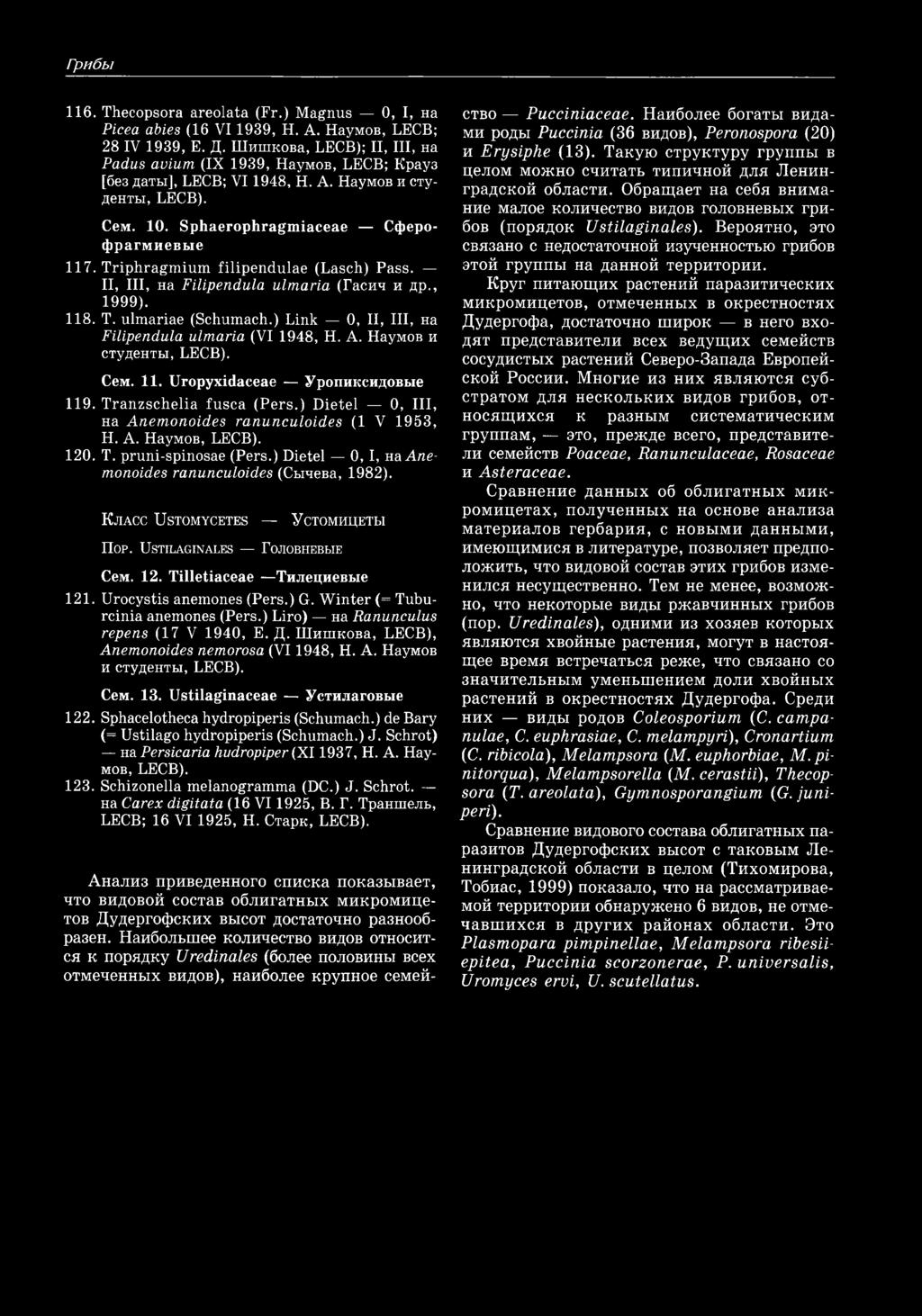False doubles
False tinder fungus can be confused with chaga, which is called a birch mushroom.
The increased attention to this variety is due to its medicinal characteristics. Chaga must be able to distinguish it from false counterparts, since they all have a hoof-like shape and grow on birches with their fruit bodies downward.
Another species with which a false tinder fungus can be confused is called a birch sponge.
It has a flattened hoof-like cap, a wrinkled surface, and a white fleshy body.
All the differences between the false tinder fungus can be seen in detail in the photo.
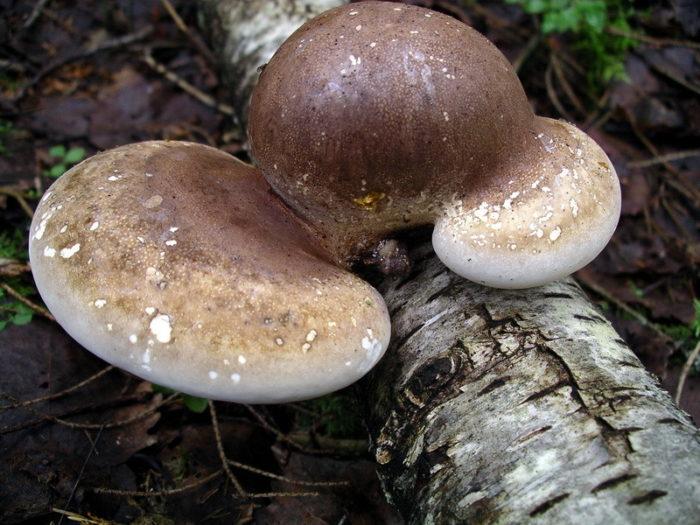
Birch sponge
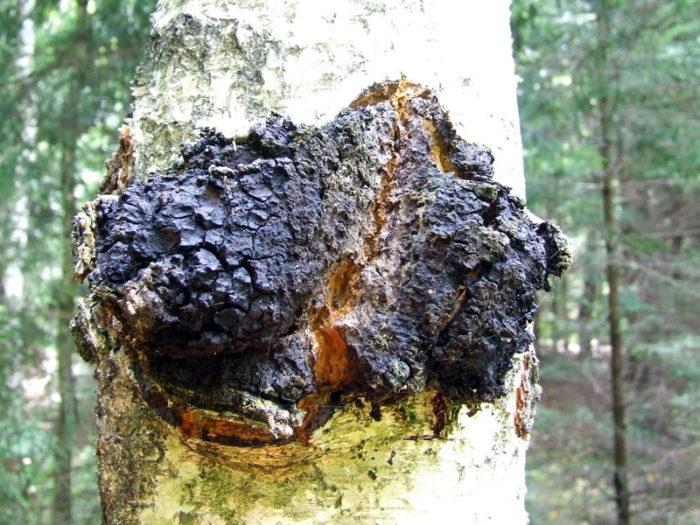
Chaga
How to distinguish a False oak tinder fungus from a real one?
The oak tinder fungus has little resemblance to its relatives, but sometimes it is confused with the powerful tinder fungus, Phellinus robustus. A distinctive feature of the latter is its color and method of attachment, the growth of the fruit body on the tree, the mushroom is easy to separate from the trunk.
The main distinguishing feature of the false tinder fungus can be called a powerful, whole fruit body, reminiscent of an animal's hoof. It is dark brown or black in color and has a rusty brown edging of a tubular layer with a stiffened structure.
Brief description of the fruiting body, characteristics and taxonomy of the parasitic fungus
False tinder belongs to the genus Fellinus of the family Hymenochetes. The inedible mushroom also has other names: Powerful Tinder fungus, Oak Tinder, Oak False Tinder. Latin names: Fomitiporia robusta, Phellinus robustus, Fomes robustus.
Fruit bodies are rounded, sometimes hoof-shaped, firmly adherent to wood. The cap is characterized by a dark gray or brown-black color, it is covered with a matte and nervous skin. Concentric brownish ridges are often located on it. The size of the fruiting body can reach 25 mm, the height reaches 12 cm.
The hymenophore is tubular, the tubes have a layered structure, their color coincides with the general color of the fruiting body. A layer of tubules appears every year, a new layer is half a centimeter in thickness. The color of this part can be rusty, brown or chestnut, sometimes darkening to dark tones as the mushroom matures.
The leg is missing. The pulp is quite tough and fibrous. The colors are red, brown or dark brown. Spores are smooth, spherical, pale yellow or colorless. Spore powder is white with yellowness.

A bit of history
The first to describe this species was the French mycologist and naturalist Lucien Kele in 1886. He gave the binomial name: Phellinus igniarius.
Interesting facts about medicinal mushroom
Translated from Latin, phellinus igniarius translates as "smoking cork." In its shape and method of attachment, the false tinder fungus is really very similar to a cork in a tree.
Tinder fungi make excellent unusual crafts, you can make funny animal figurines from them. Coated with clear varnish, the woody mushrooms take on a bright color and look great.
Polypores are easily separated from trees, and the place where the mushroom is cut is carefully leveled with a knife. To connect parts from a real tinder fungus with a knife, an awl, or another sharp object, recesses are made, which are filled with plasticine or glue, and then pointed matches or sticks are inserted.
False tinder fungus is often found in the forests of the European part of Russia. Despite its harmful qualities, it is not worth exterminating the mushroom. It can be used for decorative purposes (by making a decoration-do it yourself) or by preparing a medicinal decoction for the treatment of many diseases. In the latter case, it is imperative to consult with doctors.
No. 1 [Systematic notes on the materials of the Herbarium. P.N. Krylov, Tomsk State University, 2013]
The scientific journal "Systematic Notes on the Materials of the Herbarium of Tomsk University" was founded in 1927 by Porfiry Nikitich Krylov, as a periodical in addition to "Proceedings of the Tomsk Branch of the Russian Botanical Society." Since that time, the name of the journal has been transformed by only a few and today it contains the name of the founder - P.N. Krylov.
The journal publishes articles on the following sections of botany:
descriptions of new taxa,
systematic reviews,
floristic finds,
characters used in the taxonomy of specific taxa,
typification of taxa names.
... - Fellinus 1. Ph. chrysoloma (Fr.) Donk - F. gold-bordered, sponge sponge. 2.
Preview: Systematic notes on the materials of the Herbarium. P.N. Krylov, Tomsk State University №1 2013.pdf (0,5 Mb)
Latin-Russian Dictionary for Biologists
M .: FLINT
The dictionary is intended to help in "decoding" both Latin names
living organisms and biological terms, includes about 3 thousand
arranged in a single alphabetical order of Latin and Greek words,
on the basis of which scientific biological Latin is built. To simplify
the perception of the material in front of the actual text of the dictionary is given the original
the author's method of meaningfully memorizing Latin and Greek words,
based on their similarity to the derivative Russian words.
Phellinus nigrolimitatus - black-bounded fellinus (fungus of the family tinder) limne (gr.) - lake, pond,
Preview: Latin-Russian Dictionary for Biologists.pdf (0.2 Mb)
No. 2 [Siberian Forestry Journal, 2019]
The journal is a multidisciplinary peer-reviewed scientific publication covering a wide range of
a range of issues of forestry, forestry, forest management, forest inventory, genetics and selection, forest ecological
geology and economics - sciences about the most complex patterns of structure, formation and development of forest ecosystems and
use of forest resources by humans. "Siberian Forest Journal" includes the following sections: "Original articles", "Brief communications
niya "," Reviews "," Reviews "," Anniversaries ". It covers a variety of issues related to the problems of bio-
logical diversity of forests at all levels of its organization (genetic, species, ecosystem). Pu-
articles on anthropogenic and technogenic transformation of forest ecosystems are glimpsed. The magazine is not limited
forest problems of Siberia, accepts and publishes materials from various regions of the world, representing
general scientific interest.
.; fellinus - rusty brown Phellinus ferrugineofuscus (P. Karst.)
Preview: Siberian Forest Journal No. 2 2019.pdf (0.5 Mb)
Merchandising and customs examination of goods of animal and plant origin textbook. allowance
RIO of the Vladivostok branch of the Russian Customs Academy
The concept, signs and classification of goods of animal and plant origin are given. The characteristics of certain types of specific goods of animal and plant origin are given. The features of customs examination of objects of fauna and
flora as goods of animal and plant origin, transported across the customs border of the Customs Union, and its components - identification and cost expertise. Methods for assessing certain categories of fauna and flora objects are presented.
(oak fellinus). Pleurotus djamor (Rumph ex Fr.) Boedijn (salmon-straw oyster mushroom).
Preview: Commodity Science and Customs Expertise of Goods of Animal and Vegetable Origin Study Guide.pdf (0.6 Mb)
No. 3 [Forest Bulletin. Forestry Bulletin, 2008]
Previous name: Bulletin of the Moscow State University of Forestry - Lesnoy Vestnik (until 2016) / The journal is the leading scientific and information journal in the field of forestry, ecology, logging, woodworking, chemical technology and wood processing, forestry economics.
The journal publishes: articles by scientists of higher education, research institutes, foreign specialists, heads of enterprises and engineers; texts of reports of scientists at symposia, conferences and meetings; annotations and reviews of new books; journalistic and historical literary materials. Editor-in-Chief - Alexander Nikolaevich Oblivin, Professor, Doctor of Technical Sciences, Academician of the Russian Academy of Natural Sciences and Moscow Academy of Natural Sciences, Honored Worker of Science and Technology of the Russian Federation, President of Moscow State University of Law, Professor of the Department of Processes and Apparatuses of Woodworking Industries of the Moscow State Forestry University
On the trunks and trunks of living willows and mountain ash trees, Pellinus punctus (P. punctatus) often develops, causing igniarius) + + Blackish tinder fungus (Phellinus nigricans) + Pine sponge (Phellinus pini) + Fellinus
Preview: Bulletin of the Moscow State University of Forestry - Forest Bulletin No. 3 2008.pdf (0.6 Mb)
Tinder fungus, burnt fellinus (species complex) (Phellinus igniarius coll)
Synonyms:
- False tinder
- Polyporites igniarius
- Boletus igniarius
- Polyporus igniarius
- Fomes igniarius
- Placodes igniarius
- Ochroporus igniarius
- Mucronoporus igniarius
- Scindalma igniarium
- Pyropolyporus igniarius
- Agaricus igniarius
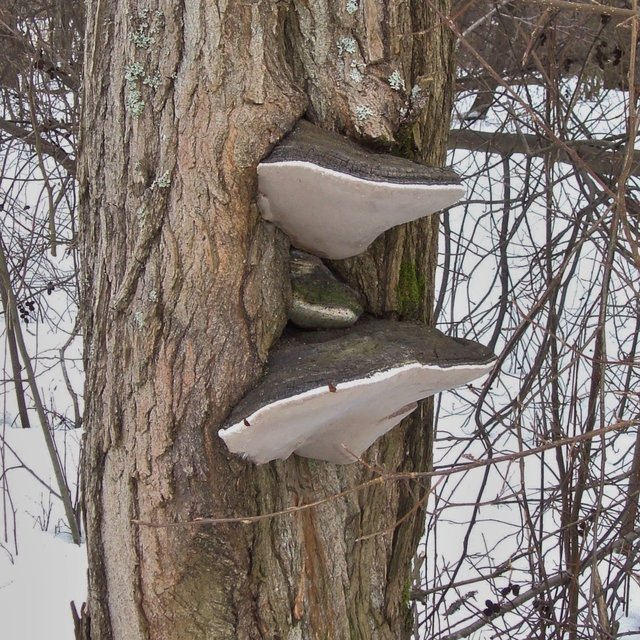
Description
Fruit bodies are perennial, sessile, of a fairly diverse shape and an average size of 5 to 20 cm in diameter, although occasionally there are specimens up to 40 cm in diameter. The thickness of the fruiting bodies varies from 2 to 12 cm, in some cases up to 20 cm. There are hoof-like variants (sometimes almost disc-shaped), cushion-shaped (especially in youth), almost spherical and slightly elongated. The shape of the fruit bodies depends, among other things, on the quality of the substrate, because as it depletes, the fruit bodies become more hoof-shaped. When growing on a horizontal substrate (on the surface of the stump), young fruiting bodies can take on truly fantasy forms. They grow to the substrate very tightly, which is generally a distinctive feature of representatives of the genus Рhellinus. They grow singly or in groups, and can share the same tree with other polypores.

The surface is dull, uneven, with concentric ridges, in very young specimens it is as if “suede” to the touch, subsequently naked. The edge is ridge-shaped, thick, rounded, especially in young specimens - but even in old specimens, although it is quite distinct, it is still smoothed, not sharp. The color is usually dark, in a gray-brown-black range, often uneven, with a lighter edge (from golden brown to whitish), although young specimens can be quite light, brownish or gray. With age, the surface darkens to black or almost black and cracks.
The fabric is hard, heavy, woody (especially with age and when it dries), rusty-brown in color, it turns black under the influence of KOH. The smell is described as "pronounced mushroom".

The hymenophore is tubular, tubules 2-7 mm long end in rounded pores with a density of 4-6 pieces per mm. The color of the hymenophore changes depending on the season, which is a characteristic feature of all representatives of this species complex. During the winter, it usually fades to light buffy, grayish or even whitish. In the spring, new tubules begin to grow, and the color changes to a rusty brown - starting from the central area - and by the beginning of summer the entire hymenophore will already be dull rusty brown.
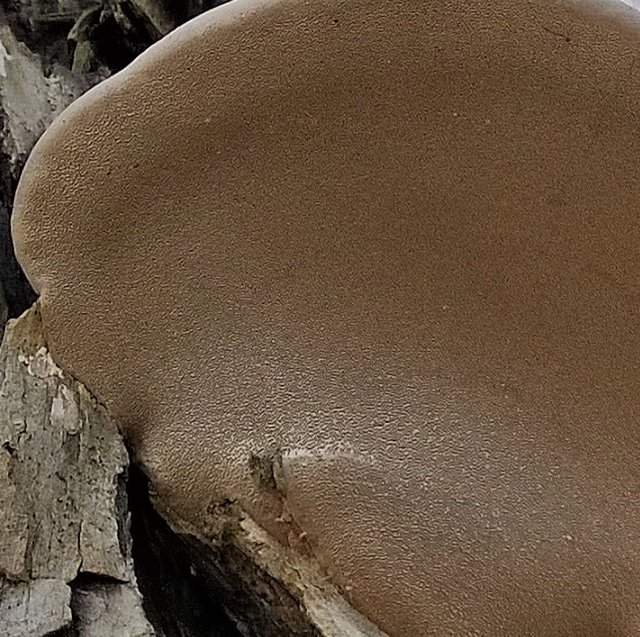
The spore print is white; the spores are almost spherical, smooth, non-amyloid, 5.5-7 x 4.5-6 microns.
Spreading
Representatives of the Phellinus igniarius complex are one of the most common polypores of the genus Phellinus. They settle on living and dying deciduous trees; they are also found on dry, valezha and stumps. They cause white rot, for which woodpeckers are very grateful to them, because it is easy to hollow out a hollow in the affected wood. Trees are infected through bark damage and broken branches. Human activities do not bother them at all, they can be found not only in the forest, but also in the park, and on the personal plot.
Special notes
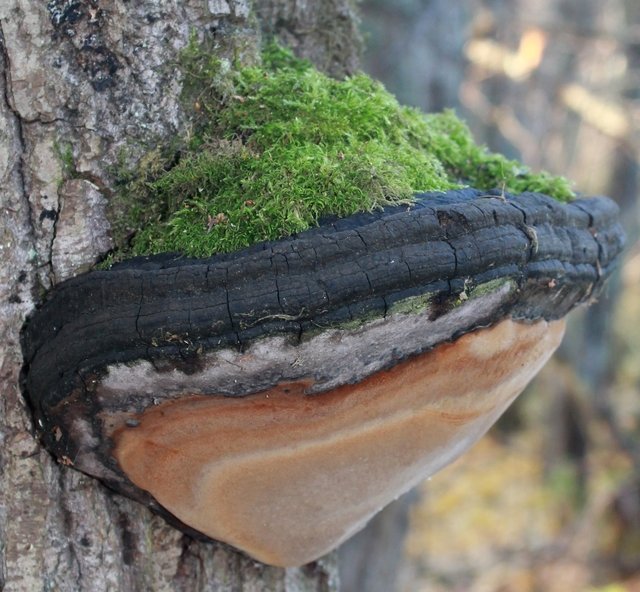
In a narrow sense, a form that grows strictly on willows is considered a species Phellinus igniarius, and those growing on other substrates are distinguished into separate forms and species - for example, the blackish tinder fungus (Phellinus nigricans) growing on birch.

However, mycologists do not have a unanimous opinion on the species composition of this complex, and since the exact definition is very difficult, and it is impossible to focus only on the host tree, this article is devoted to the entire species complex of Phellinus igniarius as a whole.
Natural complex of Vottovaara mountain: features, current state, conservation [monograph]
Karelian Scientific Center of the Russian Academy of Sciences
The monograph gives a multifaceted description and assessment of the natural complex of Vottovaara, located in the extreme southeast of the Muezersky region of the Republic of Karelia. The results of a survey of the territory by five institutes of the KarRC RAS are presented. A brief description and assessment of the general physical and geographical features of the territory (geological and geomorphological, hydrological and soil) are given. In the following, terrestrial ecosystems (swamps and wetlands, forests and landscapes in general) are described and assessed. In the next part, vascular plants, mosses, fungi, mammals, birds, insects are characterized and evaluated (with lists of species). A special place in the monograph is occupied by materials of archaeological research. In the conclusion, general conclusions are drawn and the expediency of giving the territory under consideration the status of a landscape natural monument of regional significance is substantiated.
Phellinus shell-shaped And Phellinus ferrugineofuscus (P. Karst.) Bourdot et Galzin Fellinus rusty-brown E Phellinus laevigatus (P. Karst.) Bourdot et Galzin Black-bordered Pellinus Donk Grape Pellinus E • Coltriciaceae - Coltricia perennis (L .: Fr.)
Preview: Natural complex of Vottovaara mountain features, state of the art, conservation.pdf (0.4 Mb)
Mushrooms. Class Basidiomycetes
The textbook provides a botanical and ecological description of fungi of different classes of orders, families and genera, a wide disclosure of the macro- or microscopic structure of the thallus (mycelium) of different species and a vivid illustration.
The tutorial includes 5 books.
Book 3 “Mushrooms. Class Basidiomycetes ”presents the taxonomy of heterotrophic organisms - fungi. The characteristics of the class are given with a detailed description of orders, families and genera, wide disclosure of the macro- or microscopic structure of the thallus (mycelium) of different species. Vividly illustrated.
The manual is recommended for use by teachers in laboratory classes and in preparation for lectures, for students to prepare answers to exam questions, independent work in the form of reports, messages, essays, graduate students, and also interesting for a wide range of readers.
.
Fungi of the genus Phellinus secrete a lot of peroxidase, especially the false tinder fungus (Phellinus igniarius in our forests, the flat tinder fungus (Ganoderma applanatum), as well as many fungi of the genera Inonotus and fellinus Mushrooms of the genus Phellinus are often pathogens on wood and for living trees Rusty-brown Phellinus (Phellinus ferrugineofuscus) is found on dead trunks and branches of conifers Black-striped Phellinus (Phellinus nigrolimitatus) lives on thick dead trunks and stumps of conifers
Preview: Mushrooms. Class Basidiomycetes .pdf (1,3 Mb)
Tinder Gartig (Phellinus hartigii)
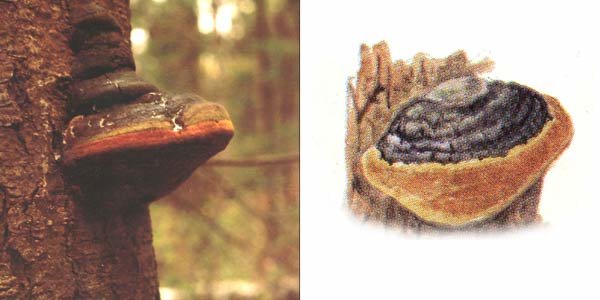
Fruit body:
the fruiting bodies of the fungus are usually formed in the lower part of the trunk from the northern side. Single fruiting bodies are perennial. Sometimes fruiting bodies grow together in several specimens. First, the fruiting bodies are nodular, then cantilever. Attached by a wide base. Quite large, about 28 centimeters wide, up to 20 centimeters thick. The upper surface is rough, with wide, staggered zones, at first it has a yellow-brown color, then changes color to a dirty grayish or blackish.As the mushroom matures, the surface cracks and becomes covered with green algae. The edges of the fruiting body are rounded, obtuse, ocher-brown or light reddish.
Hymenophore:
rusty brown or yellowish brown. The pores are angular or rounded. The tubes are arranged in several layers, each tubular layer is separated by a sterile layer.
Pulp:
woody, very hard, zoned. On the fractures, flesh with a silky sheen. Yellowish rusty or yellowish brown.
Spreading:
Tinder fungus Gartig is found in coniferous forests. Grows on conifers, usually on fir.
Similarity:
this species closely resembles the Phellinus robustus growing on the oak. The difference is the substrate and the layers of sterile tissue between the layers of the tubes.
Household purpose:
Gartig's polypore causes a pale yellow rot that is limited by narrow black lines from healthy wood. This mushroom is a dangerous pest of fir. Trees are infected through broken branches and other injuries. In the early stages of decay, the affected wood becomes fibrous, soft. Brown mycelium of the fungus accumulates under the bark, rotten branches appear. Then, depressed places are formed on the surface of the trunks, in which the fungus forms fruiting bodies.
Notes:
trees affected by tinder fungus are scattered in fir plantations singly. In the foci of infection, the infection with tinder fungus can reach 40% or more. Especially in old fir stands. The thickest trees in the stand are mainly affected. The development of rot in the trunk of such trees is accompanied by the formation of tinder bodies on the trunks. As a result, the resistance of the trees decreases, the clutter and the formation of foci of stem pests increase.
No. 5 [Pharmacy, 2013]
Scientific and practical journal for pharmacists, pharmacists, pharmaceutical manufacturers. Published since 1952.
Editor-in-chief of the journal: - Professor I. A. Samylina.
By the decision of the Plenum of the Higher Attestation Commission "Pharmacy" was included in the list of journals in which the publication of the results of dissertation research for the degree of Doctor of Science is recommended.
Journal subject: medicine production technology; new methods of drug research; falsification of drugs; clinical pharmacology; pharmaceutical market news; pharmacopoeial monographs; consultations for pharmacy workers; personnel training.
Frequency of issue - 8 magazines per year
Target audience: manufacturers of pharmaceuticals, distributors, pharmacists, pharmacists, health care workers, libraries.
Research on co-cultivation of oblique tinder fungus and Phellinus punctatus - basidial
Preview: Pharmacy # 5 2013.pdf (0.6 Mb)


